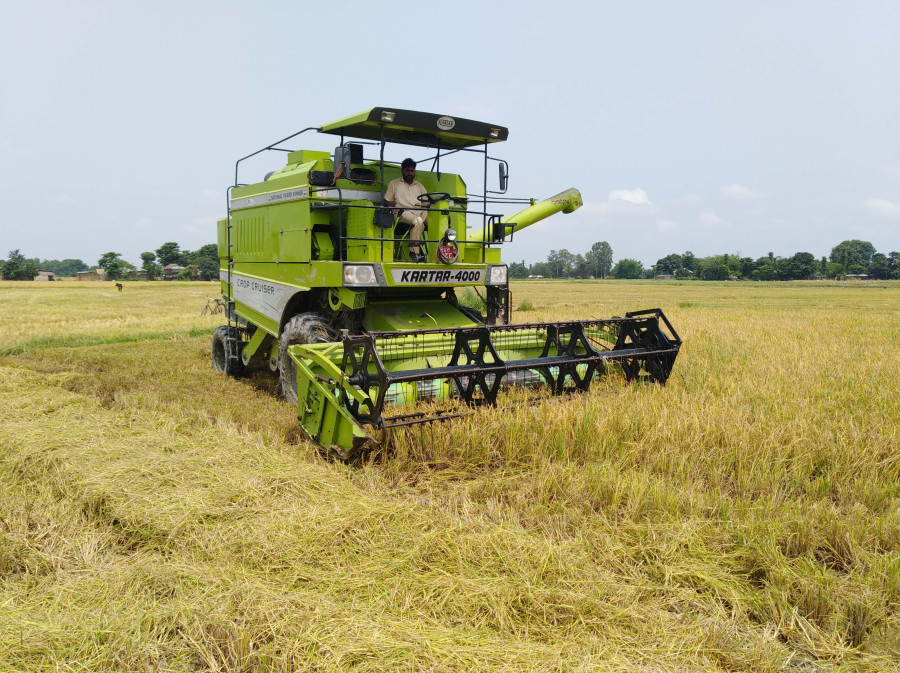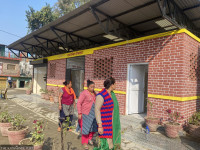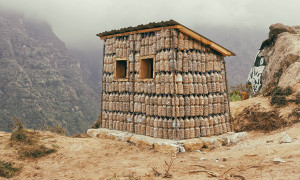Thu, Dec 25, 2025
Money
Nepal expected to harvest record 5.6m tonnes paddy
Nepal’s paddy harvest is expected to hit a record high of 5.61 million tonnes this fiscal year, according to the preliminary statistics of the Ministry of Agricultural Development slated to be released officially Wednesday.
bookmark
Sangam Prasain
Published at : December 26, 2018
Updated at : December 26, 2018 19:37
Kathmandu
Nepal’s paddy harvest is expected to hit a record high of 5.61 million tonnes this fiscal year, according to the preliminary statistics of the Ministry of Agricultural Development slated to be released officially Wednesday. The bumper crop is a 9 percent increase from the previous year, ministry officials said.
The highest ever output is a result of better-than-expected rainfall this year. The ministry’s statistics show that Nepal’s paddy productivity is expected to increase to a record high of 3.8 tonnes per hectare this fiscal year ending mid-July, up from 3.5 tonnes in the last fiscal year 2017-18.
Based on the average price of Rs21 per kg, this year’s projected paddy harvest is worth more than Rs115 billion, excluding the value of byproducts like straw and bran also totalling billions of rupees. This year’s paddy productivity is way above the country’s average productivity of 3 tonnes per hectare.
“As a majority of farmers in the Tarai region have adopted mechanisation due to a shortage of labour, it has helped increased productivity. Farm mechanisation has also reduced post-harvest losses significantly,” said a senior ministry official.
“This year, Nepali farmers received sufficient rainwater and chemical fertiliser. Besides, improved varieties of seeds have also increased productivity.”
While the plentiful harvest of paddy and other cereal crops is expected to increase farmer incomes, reduce the country’s rice import bill and cool down inflation, its wider effect will be seen in the government’s growth target as the economy is strongly dependent on agriculture.
There were no disease outbreaks or floods this year too. The monsoon is the lifeblood for Nepal’s farm-dependent Rs3 trillion economy. The country’s economy depends on how the monsoon behaves as less than 30 percent of the farmlands have round-the-year irrigation facility.
The country gets about 70 percent of its annual rainfall during the monsoon season that lasts from June to September. This year, the monsoon entered Nepal on June 8, two days before the normal onset date.
Nepal is an agricultural country with 66 percent of the population being directly engaged in farming, which accounts for about 27 percent of its gross domestic product (GDP). Due to this reason, a failed monsoon can have a ripple effect on the country’s growth and economy. A normal and well-distributed monsoon boosts farm output and farmer incomes, which in turn lifts rural earnings and boosts spending on consumer goods.
In the last fiscal year, Nepal’s paddy output totalled 5.15 million tonnes, down 1.49 percent from the 2016-17 bumper harvest, mostly on account of the August floods in the southern Tarai plains, known as the country’s food basket. The country suffered record floods following torrential rains from August 11-14 that inundated huge tracts of land in 31 districts.
Recently, Nepal Rastra Bank said in its macroeconomic report that the favourable monsoon promised a good summer harvest this year.With the turnaround in paddy production from a negative growth of 1.5 percent in 2017-18, a pickup in agricultural growth in 2018-19 is likely to underpin the sustained rebound in overall GDP growth seen in the last two years, it said.
In the previous fiscal year 2016-17, the country recorded the highest paddy production in history with a 21.66 percent jump to 5.23 million tonnes. That year, the country achieved a 23-year high economic growth rate of 7.39 percent on the back of a good monsoon that boosted agricultural output. Nepal’s farm sector registered a nine-year high growth rate of 5.32 percent.
Most Read from Money
Editor's Picks
Pradeep Adhikari’s flight to power—and the turbulent fall
Ride-hailing no easy option for students struggling to commute in Kathmandu
Is Oli’s victory over Ishwar Pokhrel also a final defeat for Bidya Bhandari?
Nepal scales back key SDG health targets
Nepal’s ban fails to stop Nepalis from working in Iraq
E-PAPER | December 25, 2025
×




 10.12°C Kathmandu
10.12°C Kathmandu














